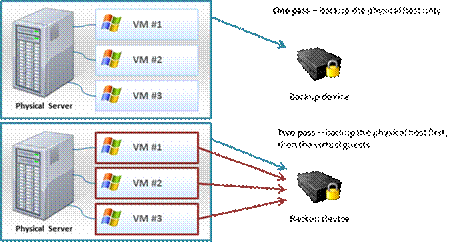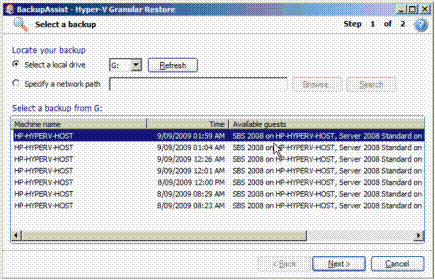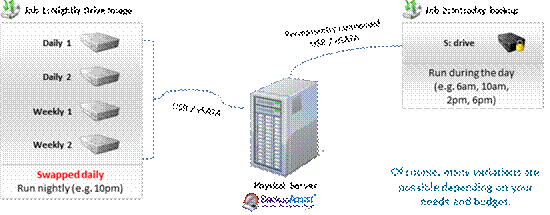Don't Hyperventilate over Hyper-V backups!!
Hyper-V backup is like one of those brain bending puzzles. It raises the blood pressure and sends even the most experienced I.T. professionals into fits of frustration. But like most puzzles, it's easy to do it - once you know how!
This Whitepaper outlines the causes of stress that go with Hyper-V backups. It also tells how BackupAssist can provide a simple solution that eliminates all the confusion and frustration once and for all, while delivering fast, reliable Hyper-V backup and restore at price you can easily afford.
Part 1: The causes of discomfort and concern.
Backing up a traditional server is one thing…
With traditional server backups, you connect a backup device to the server, schedule a backup, and let it run. There are 6 recovery scenarios you need to cater for - everything from Bare Metal Server Recovery to restoring Exchange Server and individual mail items. Fortunately the recovery procedures are generally well documented and straightforward when using well designed backup solutions.
…but it's not so simple with Hyper-V backups.
In a Hyper-V environment, things start to get more complicated.
For starters, there are another 4 recovery scenarios you need to deal with, all involving recovery of Guest VMs.
|
Recovery scenarios with a normal server Recover the entire server from bare metal Recover specific files and folders Recover a complete Exchange Server Recover individual Exchange mailboxes and Outlook items Recover SQL Server databases Onsite & offsite data protection
|
Recovery scenarios with a Hyper-V server Recover the entire Host server from bare metal Recover specific files and folders from Host Restore all Hyper-V Guest VMs to a different Host Restore a single Guest VM Restore a single Guest VM to a different Host Restore specific files & applications on a Guest VM Recover a complete Exchange Server Recover individual Exchange mailboxes and Outlook items Recover SQL Server databases Onsite & offsite data protection |
With Hyper-V, you not only have the Host Server to backup, but you also have multiple Guest VMs (Virtual Machines) within that Server to backup as well. Should you run your backups from the Host or Guests?
Unfortunately, Guest VMs won't have physical access to your backup device because Hyper-V cannot pass through USB, SCSI or SATA devices. And a backup of the Host itself is great for fast disaster recovery of the entire machine, but means that you can't recover individual files off the Guest VMs, because they are "locked" in the Guest's VHD file.
That's led some backup vendors to even recommend backing up both the Host and the Guests. But that means you're forced to do a two-pass backup, taking twice the disk space and twice the time!

Is there a backup software product that solves these problems?
Well, yes. But there's a catch.
The Hyper-V software solutions on the market are usually very expensive and seldom cover all the recovery scenarios in one package. The basic cost of the leading brand starts at US$5,000 - and that level of expense nullifies the cost savings of virtualization in the first place for many SMBs!
To add insult to injury, these solutions can also be difficult to use.
So what's the solution?
Thankfully, there is a solution. It's a fundamentally smarter approach that makes it easy to backup Hyper-V environments, caters for the 10 different recovery scenarios, and means that you only have to do a one-pass backup.
Part 2: Solving the difficulty problems.
Use BackupAssist™ to create a one pass backup that allows recovery at all levels!
Because your physical Host machine has direct access to hardware, it makes sense to backup from there. And because you're backing up from the "top level", it means that you can completely restore everything from the Host down.
Our preferred method of backup is to Drive Image the Host machine. This is also the fastest way of backing up, and with the correct backup hardware (such as eSATA connected disks with 32MB cache) you can achieve backup speeds of over 200GB/hr.
This is also a one-pass backup, which saves time and disk space.
The problem with most other one-pass backup solutions is that it's impossible to recover individual files and folders from a guest. However, that's fixed by our ingenious solution:
The BackupAssist Hyper-V Granular Restore Console.
Granular restore technology makes it possible to restore individual files and folders that live on a Guest VM, from the image backup of the Host. The BackupAssist Granular Restore Console allows you to "dig down" into the Image backup, find the restore point, choose your Guest VM, and then retrieve files from within it. It's a simple idea that completely eliminates all the time, confusion, frustration and extra data storage hardware costs associated with Hyper-V backups.
It's such a simple and straightforward process, that it takes less than 2 minutes to do, as shown in our demonstration video.

A solution that's completely compatible with Microsoft technologies.
Another great benefit of the BackupAssist Hyper-V solution is that it's completely compatible with Microsoft technologies. In fact, it actually integrates with two key features built into Windows Hyper-V Servers:
- Windows Server Backup (wbadmin) to Image the Host.
· Hyper-V Backup Integration Services - a VSS based snapshot of all Guest VMs that ensures your backups are accurately performed, even while your server is running.
This means that the BackupAssist solution is lightweight and reliable - reusing the tools and infrastructure that Microsoft has already built in, instead of reinventing the wheel.
Part 3: Solving the cost problem.
Software cost comparisons
Thanks to BackupAssist's fundamentally smarter approach of building upon the backup services already built into Windows, we've been able to deliver a quality solution at a fraction of the price of the competition.
So what cost savings can you expect? Based on a standard backup scenario, including Exchange Server mailbox backup, the cost comparison table below shows how much less BackupAssist's Hyper-V solution costs compared to the leading brand.
|
Product |
Price |
Product |
Price |
|
BackupAssist plus 12 months BackupCare |
$345.85 |
Competitor product - for Windows Servers License + Essential 12 Months Support |
$1162.66 |
|
BackupAssist Hyper-V Granular Restore Add-on |
$249.00 |
Competitor product - System Recovery Server Edition License + Essential 12 Months Support |
$1279.51 |
|
BackupAssist Exchange Mailbox Add-on |
$129.00 |
Competitor product - Agent for Microsoft Virtual Server License + Essential 12 Months Support |
$2915.41 |
|
Total |
$723.85 |
Total |
$5357.58 |
Hardware & labor costs
As you can see from the diagram below, the BackupAssist Hyper-V backup solution should cost no more than a setup for a regular server. Example of a BackupAssist Hyper-V backup setup:

How much time will you save with the BackupAssist Hyper-V solution? BackupAssist provides simple point and click wizards to schedule the backups. You also enjoy the ease and convenience of BackupAssist's regular features, like media rotation, reminder emails and report emails that significantly cut down on time and effort and help to ensure your backups are completed successfully, so you can rest assured your data is secure (for more information visit www.backupassist.com).
Additional benefits of BackupAssist
Apart from doing an excellent job at backing up Hyper-V Servers, BackupAssist has many additional capabilities that make it the most versatile SMB backup package available:
![]() Drive Imaging on Server 2008
Drive Imaging on Server 2008
![]() Fast compressed data backup with our new Zip Engine to:
Fast compressed data backup with our new Zip Engine to:
- Tape
- External/local disk
- NAS
- USB Flash
- DVD and more
![]() Bandwidth efficient Internet backup
Bandwidth efficient Internet backup
![]() Centralized Monitoring and a comprehensive range of features for IT Professionals!
Centralized Monitoring and a comprehensive range of features for IT Professionals!

 Belgium
Belgium Canada
Canada Germany
Germany Italy
Italy France
France Spain
Spain United Kingdom
United Kingdom

